Trees Birds Mammals Fish Amphibians Reptiles
Wild Algarve
Bookshop
Sparassis spathulata (Schwein.) Fr.
Phylum: Basidiomycota - Class: Agaricomycetes - Order: Polyporales - Family: Sparassidaceae
Distribution - Taxonomic History - Etymology - Identification - Culinary Notes - Reference Sources
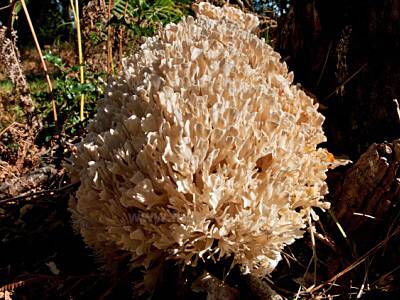
This large fungus, easily mistaken for Wood Cauliflower Sparassis crispa, is very rare in Britain and Ireland, where it is found mainly at the bases of oak, beeches and occasionally pines
Fungi in the genus Sparassis are generally referred to as 'cauliflower' fungi because from a distance the globose pale fruitbodies resemble the cultivated brassica commonly used as a vegetable. Cauliflower fungi are edible when cooked, but they do not taste like their vegetable lookalikes.
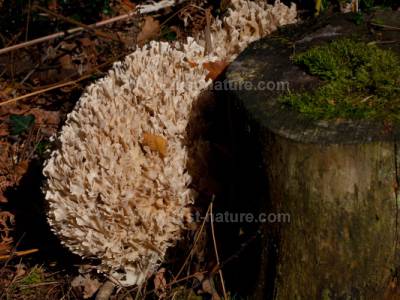
Distribution
Sparassis spathulata is a very rare sight in Britain and Ireland. This species is also found in central and northern mainland Europe and is recorded in other parts of the world including North America (although spore dimensions there are somewhat larger than in Europe and may indicate that these are not co-specific with the European type).
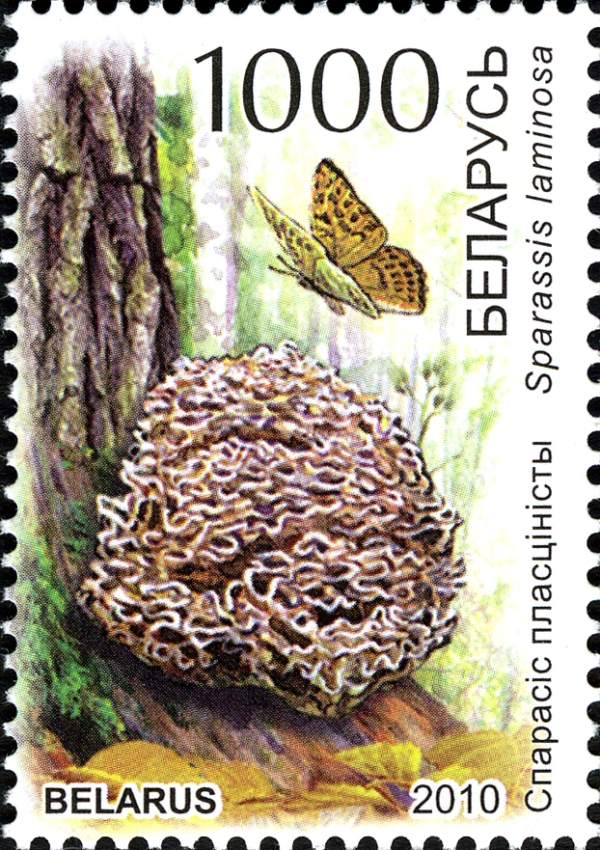
Above: Sparassis spathulata featured on postage stamps of Belarus
Taxonomic history
In 1822 this remarkable fungus was described and named by American mycologist Lewis David von Schweinitz (1780 - 1834) and given the binomial scientific name Merisma spathulatum. The great Swedish mycologist Elias Magnus Fries renamed this species as Sparassis spathulata.
Synonyms of Sparassis spathulata include Merisma spathulatum Schwein., Sparassis brevipes Krombh., Sparassis laminosa Fr., Sparassis crispa var. laminosa (Fr.) Quél., and Sparassis simplex D.A. Reid,
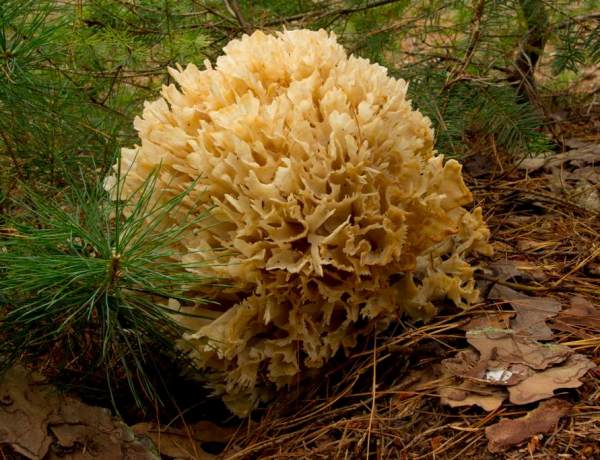
Etymology
The generic name Sparassis is derived from a Greek verb meaning to tear - the fronds of the fruitbody are divided as though they have been torn; and the specific epithet spathulata translates to spade-like (flattened like a spatula.
Identification Guide
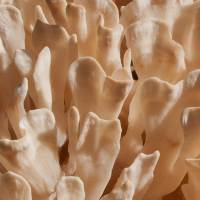 |
10 to 25cm tall and up to 20cm across, the fruitbody is more or less hemispherical and comprises many spade-like lobes, creamy white but with conspicuous brownish colour zones, which arise from a single basal stem. (In comparrison Sparassis crispa has a branched basal stem and is reported to be not as tough in texture as Sparassis spathulata.)
|
| |
Spores
Broadly ellipsoidal, smooth, 4.5-6 x 3.5-4.5µm, inamyloid.
Spore print
Creamy-white.
Hyphal structure
Clamp connections are present (whereas they are sometimes absent in Sparassis crispa). |
Odour/taste |
Faint mushroomy smell; taste mild and pleasant. |
Habitat & Ecological role |
Sometimes weakly parasitic but probably more often saprobic (on mainland Europe often seen feeding on dead and sometimes well-rotted conifer stumps), fruitbodies emerge from the ground (the base being attached to underground roots) beside hardwood trees and occasionally Scots Pine. |
Season |
July to October in Britain and Ireland. |
Similar species |
Wood Cauliflower Sparassis crispa has curled fronds arising from a branched basal stem.
Grifola frondosa is found at the bases of oak trees and also forms a cauliflower-like shape, but its fan-shaped segments have pores on the underside; it is grey-brown. |
Culinary Notes
Unfortunately Sparassis spathulata is very rare in Britain and Ireland, and so it is generlly considered inappropriate to gather these fruitbodies for eating.
Sparassis fungi are generally considered edible when young and fresh, but the fruitbodies should
not be eaten once they begin decaying. Often the hardest part of the preparation process is extracting all of the debris, some of which the fruitbodies may have grown up through. Cauliflower fungi are very good when either baked or fried, and of course you can always add them to soups and stews. Cut the fungus into small florets, making sure that no debris in included within the fronds of the fungus.Cauliflower fungi can be used as the basis of a delicious Cauliflower (Fungus!) Cheese, and once you have made a nice cheesy sauce (Parmesan is an ideal basis for this) you simply pour it over a greased oven-proof dish of florets of Wood Cauliflower and then bake in the oven until the top is golden brown, just as you would if using vegetable cauliflower. Sparassis fungi are also among the very best fungi for drying, because they re-constitute so well.
Reference Sources
Dictionary of the Fungi; Paul M. Kirk, Paul F. Cannon, David W. Minter and J. A. Stalpers; CABI, 2008
Taxonomic history and synonym information on these pages is drawn from many sources but in particular from the British Mycological Society's GB Checklist of Fungi.
Acknowledgements
This page includes pictures kindly contributed by David Kelly.
Top of page...
Fascinated by Fungi. Back by popular demand, Pat O'Reilly's best-selling 450-page hardback book is available now. The latest second edition was republished with a sparkling new cover design in September 2022 by Coch-y-Bonddu Books. Full details and copies are available from the publisher's online bookshop...